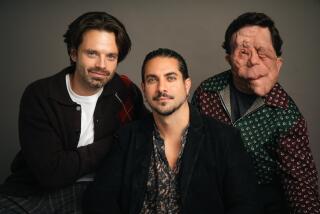Add Dash of Reverb, Mix Well
- Share via
In the burgeoning corner of the entertainment industry that creates high-tech special effects, it’s the visual effects--rampaging dinosaurs and the like--that get all the glory. But Stephen Dewey and his Venice company, Machine Head, are leading an equally dramatic revolution in the comparatively mundane world of sound.
Dewey, 40, a soft-spoken, philosophical Englishman, spends his days and nights creating noises for commercials, television, movie trailers and movies. The idea, in essence, is to “design” sounds that are more real than the real thing.
“I find the sonic textures that suggest the energy and excitement that make the viewer believe he is hearing what he is seeing,” says Dewey.
Once the exclusive province of film, sound design is now spreading quickly, especially to TV commercials, as ad agencies and their clients realize the potential impact sound can have.
And directors--such as brothers Tony and Ridley Scott, who are crossing back and forth from feature films to commercials--are bringing higher expectations and technical standards. Machine Head’s work can be seen--or, more accurately, heard--as the soundtrack to commercials for United Airlines, Nike, Chevrolet and Coca-Cola, among others.
The Machine Head designers use natural sounds that they record and then manipulate, as well as sounds created on synthesizers and musical instruments. To make sure they always have the right raw material, Dewey and his staff have recorded more than 300 hours of sounds--burned into CDs for storage--and have a library of hundreds of sound-effect CDs.
They import the sounds--from CD, tape and other sources--into a Macintosh. From there the sound can be played backward or forward, at any pitch, and otherwise tailored to fit a specific image.
For a Lexus commercial in which one arrow was shot through the center of another arrow to illustrate the concept of perfection, Dewey used an array of sounds, adding a blast of air and a kick-drum to the natural sound for the moment when the second arrow embeds itself in the first. A hand grenade sound effect accompanied the release of the arrow, and the slowed-down sounds of frogs and a bass guitar underscored the arrow’s flight.
The technicians often use such a collage, much as an artist blends colors on the palette or a chef combines various ingredients in a successful recipe. It takes an open mind and a good ear to imagine which unlikely sounds might combine for just the right effect.
Now 6 years old, Machine Head is one of the largest firms in a fragmented field, with 15 employees, offices in Venice and New York; it plans to open a European office next year. Rivals include similarly sized independent companies such as Tomandandy, Elias & Associates and Primal Scream, as well as an in-house group at Sony Pictures and George Lucas’ pioneering Skywalker Sound.
Sound design can be traced back to the early Warner Bros. cartoons, and “Forbidden Planet,” the 1956 sci-fi classic, was among the first movies to introduce synthesizer-created sounds to the screen. Sound designers in the pre-computer era went out and recorded sounds and then manipulated them on tape, speeding them up or slowing them down, literally splicing together different sounds.
Today it’s a technology-intensive business, from state-of-the-art software for capturing, manipulating and editing sounds to ISDN phone lines for rapid transmission of data. These advances allow sound designers greater flexibility and have opened up new possibilities for creating sounds.
For Dewey, who shares his office with his dachshund and golden retriever, success was long in coming. Growing up, he “messed around with tape recorders” and spent hours recording and altering sounds. His interests led him to rock ‘n’ roll. After a stint in the technical crew of the Thompson Twins and a short-lived apprenticeship with record producer Roy Thomas Baker (the Cars, Queen), Dewey found himself unemployed and struggling.
“It was pretty dire,” he recalls. Dewey worked several nonmusical jobs before giving up on Los Angeles, and he rejoined and left the Twins several more times while trying to figure out his future.
In his final years with the band, Dewey created and manipulated sounds for the group on the Fairlight CMI, an exotic, powerful $80,000 synthesizer. Dewey eventually left to work for the Fairlight company, but only briefly. The company folded and Dewey was out on his own again.
Dewey then went to work assisting a Fairlight player who worked on records, films and commercials and learned enough to move into a job doing sound effects for some NBC promotional spots.
From there, Dewey began to find work in film. Composer Hans Zimmer, who worked on the Fairlight himself, called Dewey in to create special sounds for the Ridley Scott-directed film “Black Rain.” When that went well, Scott called on Dewey again for sounds for a commercial he was doing, which brought Dewey to the attention of ad agency Chiat/Day. He’s worked steadily ever since, in a field he truly enjoys.
“It makes everything come to life,” says Dewey. “It all pays off when the right sound is finally matched with the image.”
*
Freelance writer Chris Rubin can be reached via e-mail at [email protected]
More to Read
The biggest entertainment stories
Get our big stories about Hollywood, film, television, music, arts, culture and more right in your inbox as soon as they publish.
You may occasionally receive promotional content from the Los Angeles Times.










